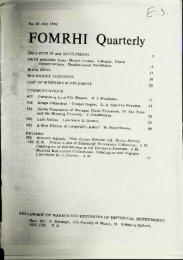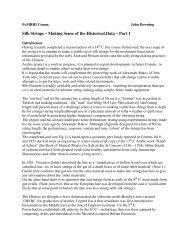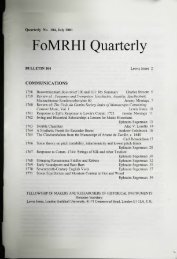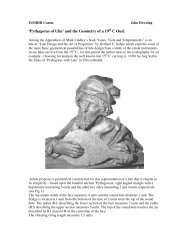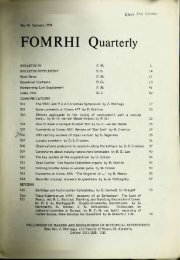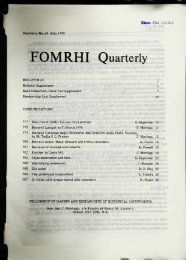• I f - FoMRHI
• I f - FoMRHI
• I f - FoMRHI
Create successful ePaper yourself
Turn your PDF publications into a flip-book with our unique Google optimized e-Paper software.
20<br />
<strong>FoMRHI</strong> Comm. 160 3 Steve Heavens<br />
Schmelzer's Violino Piffaro<br />
A Sonata per chiesa e per camera by Johann Schmelzer published as a modem edition in<br />
1995 by Musikverlag Alfred Coppenrath contains some unusual instrumentation:<br />
Flauto, violino piffaro, violino I, violino U, viola I, viola U, fagotto, organo.<br />
The flauto (recorder) and the 'violino piffaro' play together throughout as a concertate group<br />
separate from the normal violins and violas which themselves form a 4-part choir. The<br />
range of the violino piffaro part is quite nanow, from a* to b"; i.e. playable on a normally<br />
tuned violin on the top two strings in first position.<br />
It is not clear from the editorial commentary whether the original spelling was 'piffaro' or<br />
'piffero', but since the instrument pairs with a recorder, the intended meaning is presumably<br />
not Praetorius' piffaro = shawm = Schallmey-Geigl as the editor describes it, but rather<br />
fiffaro = pipe or fife = piffero in modem Italian.<br />
I could find no reference to a 'violino piffero' (or piffaro, or pifferato) in any of the standard<br />
references. It seems that the only article so far contributed on this instrument is that of<br />
Markus Spielmann "Violino pifferato and Viola di Fagotto" in a Viola-Symposium,<br />
Innsbruck 1987. I have not managed to consult this article but the gist of it is clear from the<br />
editorial commentary.<br />
Web searches on 'violino piffaro' and its variants failed to throw up anything. 'Viola di<br />
fagotto' yielded 2 references:<br />
(1) a Viola da Gamba Society of America page, which reproduced H. M. Brown's entry in<br />
New Grove: "a bowed string instrument with the tuning and range of a cello, but played on<br />
the arm like a viola. Some of its strings were overspun with copper wire in such a way that<br />
it produced a buzzing sound, like a bassoon (fagotto)." No sources or surviving evidence for<br />
this are given.<br />
(2) several invitations to "get a free adult site membership". This usage of musical<br />
instrument terminology was reminiscent of Thomas d'Urfey's Pills to Purge Melancholy,<br />
but after a couple more mouse clicks I decided not to pursue this particular line of enquiry.<br />
The suggestion in the Spielmann paper is that 'violino piffaro' meant a violin with overspun<br />
strings that produced a metallic or silvery sound, contrasting with the gut of the normal<br />
violin band. I think it is more likely that the instrument was strung in a scordatura tuning,<br />
either partly or completely with metal strings.<br />
Amongst late 17th century Austrian violin music there is a fair amount of multiple stopping,<br />
scordatura, pizzicato and other fancy techniques that make effective use of the resonant<br />
qualities for which Jacob Stainer's instruments were renowned. The Austrians were<br />
evidently keen on creating varieties of sound colour with the violin band for representational<br />
or theatrical type music, such as bells, animals, fencing matches etc. So a predilection to<br />
experiment with different methods of stringing could be expected.





